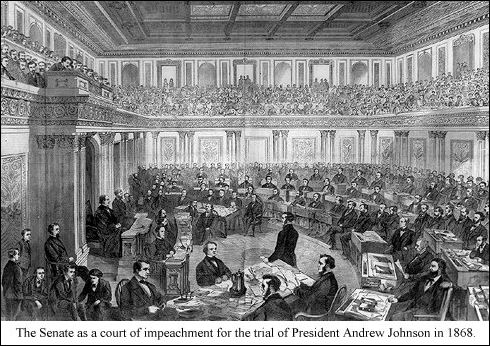![]()


The United States Constitution states in Article II, Section 4: "The President, Vice President and all civil Officers of the United States, shall be removed from Office on Impeachment for, and Conviction of, Treason, Bribery, or other high Crimes and Misdemeanors."
Thus far in the history of the United States there been three Presidential impeachment proceedings -- in 1868 against President Andrew Johnson for his removal of Secretary of War Edwin Stanton in violation of the Tenure of Office Act - 1974 against President Richard Richard Nixon for the Watergate coverup (106 years after Johnson) - 1998-99 against President Bill Clinton for concealing an extramarital affair (24 years after Nixon).
Modern Impeachment Procedure:
- Impeachment resolutions made by members of the House of Representatives are turned over to the House Judiciary Committee which decides whether the resolution and its allegations of wrongdoing by the President merits a referral to the full House for a vote on launching a formal impeachment inquiry.
- The entire House of Representatives votes for or against a formal impeachment inquiry, needing only a simple majority (a single vote) for approval.
- If approved, the House Judiciary Committee conducts an investigation to determine (similar to a grand jury) if there is enough evidence to warrant articles of impeachment (indictments) against the President. The Committee then drafts articles of impeachment pertaining to specific charges supported by the evidence. The Committee votes on each article of impeachment, deciding whether to refer each article to the full House for a vote.
- If the House Judiciary Committee refers one or more articles of impeachment, the entire House of Representatives votes on whether the article(s) merit a trial in the Senate, needing only a simple majority for approval.
- If the full House approves at least one article of impeachment, the President is technically impeached and the matter is referred to the U.S. Senate. The House then appoints members of Congress to act as managers (prosecutors).
- The trial of the President is held in the Senate with the Chief Justice of the U.S. Supreme Court presiding. The President can be represented by anyone he chooses. He may appear personally or leave his defense in the hands of his lawyers.
- The entire Senate may conduct the trial or it or it may be delegated to a special committee which would report all the evidence to the full Senate.
- The actual trial is conducted in a courtroom-like proceeding including examination and cross-examination of witnesses. During questioning, Senators remain silent, directing all questions in writing to the Chief Justice.
- After hearing all of the evidence and closing arguments, the Senate deliberates behind closed doors then votes in open session on whether to convict or acquit the President. The vote to convict must be by a two thirds majority, or 67 Senators. If this occurs, the President is removed from office and is succeeded by the Vice President. The Senate's verdict is final and there is no right of appeal.
The Presidents

- President Andrew Johnson Impeachment
- President Richard Nixon Impeachment Proceedings
- President Bill Clinton Impeachment
[ The History Place Main Page | American Revolution | Abraham Lincoln | U.S. Civil War | Child Labor in America 1908-1912 | John F. Kennedy Photo History | Vietnam War | Apollo 11 Lunar Mission | The Rise of Hitler | Triumph of Hitler | Defeat of Hitler | Timeline of World War II in Europe | Holocaust Timeline | Photo of the Week | This Month in History | Books on Hitler's Germany | History Videos | Hollywood's Best History Movies | Advertise | Send Feedback ]
Copyright © 2000 The History Place™ All Rights Reserved
Term of use: Private home/school non-commercial, non-Internet re-usage only is allowed of any text, graphics, photos, audio clips, other electronic files or materials from The History Place.

